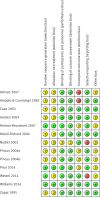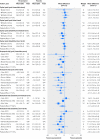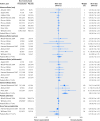Efficacy and safety of paracetamol for spinal pain and osteoarthritis: systematic review and meta-analysis of randomised placebo controlled trials
- PMID: 25828856
- PMCID: PMC4381278
- DOI: 10.1136/bmj.h1225
Efficacy and safety of paracetamol for spinal pain and osteoarthritis: systematic review and meta-analysis of randomised placebo controlled trials
Abstract
Objective: To investigate the efficacy and safety of paracetamol (acetaminophen) in the management of spinal pain and osteoarthritis of the hip or knee.
Design: Systematic review and meta-analysis.
Data sources: Medline, Embase, AMED, CINAHL, Web of Science, LILACS, International Pharmaceutical Abstracts, and Cochrane Central Register of Controlled Trials from inception to December 2014.
Eligibility criteria for selecting studies: Randomised controlled trials comparing the efficacy and safety of paracetamol with placebo for spinal pain (neck or low back pain) and osteoarthritis of the hip or knee.
Data extraction: Two independent reviewers extracted data on pain, disability, and quality of life. Secondary outcomes were adverse effects, patient adherence, and use of rescue medication. Pain and disability scores were converted to a scale of 0 (no pain or disability) to 100 (worst possible pain or disability). We calculated weighted mean differences or risk ratios and 95% confidence intervals using a random effects model. The Cochrane Collaboration's tool was used for assessing risk of bias, and the GRADE approach was used to evaluate the quality of evidence and summarise conclusions.
Results: 12 reports (13 randomised trials) were included. There was "high quality" evidence that paracetamol is ineffective for reducing pain intensity (weighted mean difference -0.5, 95% confidence interval -2.9 to 1.9) and disability (0.4, -1.7 to 2.5) or improving quality of life (0.4, -0.9 to 1.7) in the short term in people with low back pain. For hip or knee osteoarthritis there was "high quality" evidence that paracetamol provides a significant, although not clinically important, effect on pain (-3.7, -5.5 to -1.9) and disability (-2.9, -4.9 to -0.9) in the short term. The number of patients reporting any adverse event (risk ratio 1.0, 95% confidence interval 0.9 to 1.1), any serious adverse event (1.2, 0.7 to 2.1), or withdrawn from the study because of adverse events (1.2, 0.9 to 1.5) was similar in the paracetamol and placebo groups. Patient adherence to treatment (1.0, 0.9 to 1.1) and use of rescue medication (0.7, 0.4 to 1.3) was also similar between groups. "High quality" evidence showed that patients taking paracetamol are nearly four times more likely to have abnormal results on liver function tests (3.8, 1.9 to 7.4), but the clinical importance of this effect is uncertain.
Conclusions: Paracetamol is ineffective in the treatment of low back pain and provides minimal short term benefit for people with osteoarthritis. These results support the reconsideration of recommendations to use paracetamol for patients with low back pain and osteoarthritis of the hip or knee in clinical practice guidelines.
Systematic review registration: PROSPERO registration number CRD42013006367.
© Machado et al 2015.
Conflict of interest statement
Competing interests: All authors have completed the ICMJE uniform disclosure form at
Figures




Comment in
-
Managing back pain and osteoarthritis without paracetamol.BMJ. 2015 Mar 31;350:h1352. doi: 10.1136/bmj.h1352. BMJ. 2015. PMID: 25828857 No abstract available.
-
Danger of generalising findings on paracetamol for low back pain.BMJ. 2015 Apr 28;350:h2220. doi: 10.1136/bmj.h2220. BMJ. 2015. PMID: 25920321 No abstract available.
-
Paracetamol should remain the first line option for persistent pain.BMJ. 2015 Apr 28;350:h2221. doi: 10.1136/bmj.h2221. BMJ. 2015. PMID: 25922188 No abstract available.
-
Authors' reply to Adam and to Veal and Thompson.BMJ. 2015 Apr 28;350:h2223. doi: 10.1136/bmj.h2223. BMJ. 2015. PMID: 25922280 No abstract available.
-
[Paracetamol is ineffective for back pain and only minimally effective for osteoarthritis].Praxis (Bern 1994). 2015 Jul 1;104(14):757. doi: 10.1024/1661-8157/a002065. Praxis (Bern 1994). 2015. PMID: 26135728 German. No abstract available.
-
ACP Journal Club. Review: Acetaminophen reduces pain in hip or knee osteoarthritis by a small amount, but not low back pain.Ann Intern Med. 2015 Jul 21;163(2):JC10. doi: 10.7326/ACPJC-2015-163-2-010. Ann Intern Med. 2015. PMID: 26192578 No abstract available.
-
Paracetamol is ineffective for spinal pain and knee and hip osteoarthritis.Evid Based Med. 2015 Dec;20(6):205. doi: 10.1136/ebmed-2015-110221. Epub 2015 Sep 7. Evid Based Med. 2015. PMID: 26345186 No abstract available.
-
Er det slut med paracetamol til rygsmerter?Ugeskr Laeger. 2015 May 11;177(20):995. Ugeskr Laeger. 2015. PMID: 26535438 Danish. No abstract available.
References
-
- Cross M, Smith E, Hoy D, et al. The global burden of hip and knee osteoarthritis: estimates from the Global Burden of Disease 2010 study. Ann Rheum Dis 2014;73:1323-30. - PubMed
-
- Hoy D, March L, Brooks P, et al. The global burden of low back pain: estimates from the Global Burden of Disease 2010 study. Ann Rheum Dis 2014;73:968-74. - PubMed
-
- Hoy D, March L, Woolf A, et al. The global burden of neck pain: estimates from the Global Burden of Disease 2010 study. Ann Rheum Dis 2014;73:1309-15. - PubMed
-
- United States Bone and Joint Initiative. The burden of musculoskeletal diseases in the United States. 3rd ed. American Academy of Orthopaedic Surgeons, 2014. www.boneandjointburden.org.
Publication types
MeSH terms
Substances
LinkOut - more resources
Full Text Sources
Other Literature Sources
Medical
